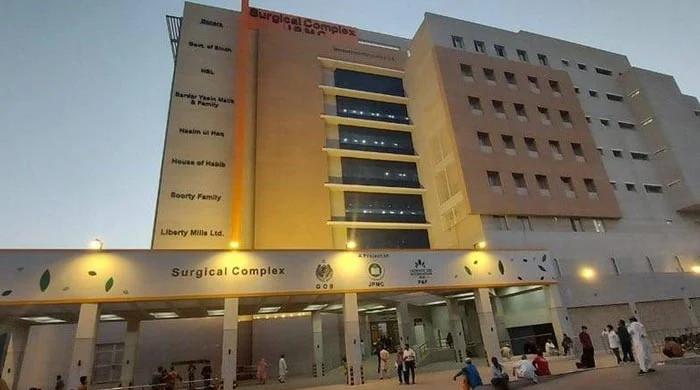Federal cabinet approves country’s largest initiative of 'Living Indus': Sherry Rehman
"Living Indus" initiative aims at protecting cradle of civilisations which are under serious threat due to environmental degradation, anthropogenic activities
September 29, 2022

- Living Indus initiative aims at protecting cradle of civilisations which are under serious threat.
- “We will have to ensure development in harmony with nature not against nature," she says.
- Sherry Rehman says ministry, would seek financing after the humanitarian phase ends in the country.
ISLAMABAD: Climate Change Minister Senator Sherry Rehman on Thursday announced that the federal cabinet has approved the country’s largest "Living Indus" initiative that is aimed at protecting the cradle of civilisations which was under serious threat due to environmental degradation and anthropogenic activities.
Addressing a media briefing flanked by Secretary Ministry of Climate Change Asif Hyder Shah, the minister unveiled the salient features of the project that has been conceived after thorough consultations with the academia, experts, stakeholders and provincial governments.
Rehman said the Indus River was the mother of the nation as it fed the entire agriculture and humanity living around it from the north to the south.
“We will have to ensure development in harmony with nature, not against nature.”
The United Nations, she said had assisted the Ministry of Climate Change to develop a detailed report on the Indus River to devise a well-thought strategy to initiate its conservation and restoration as a living river.
The minister underlined that the nature, topography and biodiversity of the Indus River change with every area it passes by.
“The marine species are under threat whereas the most at risk are the humans living across the mighty river. The Indus River exploded due to massive floods in 2010 and in recent torrential rains. We will have to find ways to revive natural routes of the Indus River.”
While elaborating on the Living Indus Initiative, the minister informed that 25 initial interventions that were the priority areas would be focussed. Moreover, access to adaptation would be the centre of our defence strategy and climate change mitigation planning.
“As we have to ensure climate resilient development and growth the access of adaptation will be our main focus.”
She added that the ministry would also lead to interventions on loss and damage, and climate financing at the global foras. The minister expressed her pride to launch Living Indus Initiative.
The minister while elaborating the key 25 interventions said that the project would operate in the length and breadth of the country whereas the private sector would be required to chip in the finances as there was a lack of resources.
“Our all funds have been diverted to humanitarian funds to rehabilitate flood victims. Climate adaptation and resilience funds have also been moved in this effort.”
The ministry, she said would seek financing after the humanitarian phase ends in the country.
The 25 priority interventions, she informed were:
- Nature-based resilience agriculture
- Salinity control in lower Indus
- Indus delta protection
- Indus cleanup from industrial effluent
- Green infrastructure and ground recharge
- Groundwater governance
- One lac community bonds
- Living Indus knowledge platform
- Indus trust fund, climate nature performance bonds
- Social entrepreneurship for green Indus
- Zero plastic waste cities along Indus
- The urban forest along Indus
- Indus protection act
- Protection of Indus beds
- Built back biodiversity in the Indus basin
- Community-based tourism in Sindh
- Indus heritage sites,
- Expanded GLOF II
- Promoting permaculture and others
She said this initiative was of every government including that of the provinces as these projects would be piloted in provinces.
Pakistan paid a huge cost in the agriculture sector due to heatwaves, she said, adding, “This the matter of our survival. The shrinking size of Palla Fish and other species is clear evidence of environmental degradation and habitat loss in polluted the Indus River.”
She mentioned that all provinces were dumping industrial effluent that needed to be addressed through stakeholder engagement.
The living database under the Initiative would provide standardised data and the ministry would take all necessary steps in this regard, she said.
“We will encourage plastic pollution control through public and community participation, not penalisation. Pakistan has been the home to hottest cities this year and exceeded 53 degrees celsius temperature.”
The minister underlined that the Indus River was the world’s second most polluted river.
Secretary MoCC Asif Hyder Shah on the occasion said these interventions have massive community involvement to have ownership of the local populace and were a long-term intervention.
Responding to media queries, he said the consultative process involved experts, academia and provincial governments for the Initiative whereas the steering committee would have all provinces’ chief ministers on board to execute the project.
“It will have a public-private partnership, government and international funding.”
Replying to queries, the minister said it was the biggest adaptation project that should be promoted for the benefit of the country.
“There has been criminal negligence of the previous regime on Climate Adaptation Plan as many initiatives ended up on paper during Imran regime.”
By the end of this year, she said the ministry would ensure legislation that conventionally used to take two years.
“The Living Indus Initiative will cost $11-17 billion. We will try to manage it through the fiscal facilities available. We will launch it at COP 27 as well.”











